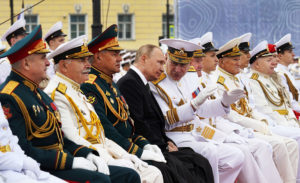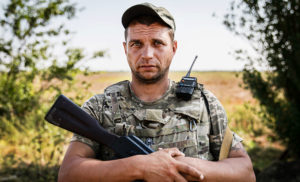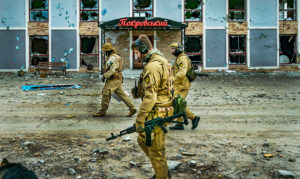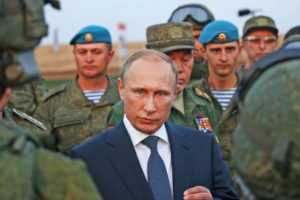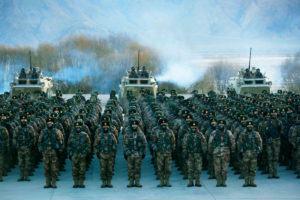As the first 250 days of Russia’s war in Ukraine have proved again, the logic of strategy is paradoxical. It has never been linear, as in the Roman Si vis pacem para bellum: if you want peace prepare for war. Because the logic of strategy is paradoxical, it is very easy to be wrong in matters of peace and war, and very hard to be right.
That was the first lesson of the war: Putin collided head-on with the paradoxical logic of strategy. Military alliances need a shared enemy. Once the Cold War ended, Nato became weaker and weaker, because diverse interests — including the desire to spend less — naturally arose once there was no enemy to threaten all. Nato became so weak that in Europe there was talk of a military alliance without the US. Only irrelevant Leftists said this straight out, but many mainstream politicians across Europe kept hinting that the time had come for Nato to be replaced by a European Union alliance.
By February 2022, Nato was evidently no longer strong enough to deter Russia, so Russia attacked Ukraine. Because Russia attacked Ukraine, Nato suddenly had a threatening enemy, and the alliance quickly became strong once more. Many Nato countries sent military aid to Ukraine rapidly, which was essential materially, and very encouraging morally. Some of it was for show, but much was useful and some was just smart. Norway, for example, immediately sent 5,000 LAW hand-launched anti-tank rockets. Old, cheap and limited in range but the perfect weapons for the first days of this war, because anybody could use them even without training. Just point and shoot at an armoured vehicle.
Not only did Nato wake up, but it also grew. Within days of the invasion, the alliance started expanding. Australia, not a Nato member but an official “partner”, sent military aid (including Bushmaster armoured cars by airlift over 19,600 kilometres). Japan, not a Nato member, sent important financial aid. Even before they applied for Nato membership, Sweden and Finland also sent military aid.
The second lesson of the war concerned the silent role of seapower. In April, the sinking of the Russian flagship Moskva 80 nautical miles south of Odessa attracted much attention. Videos of the burning ship were everywhere. But there are no videos of aero-naval battles in the North Atlantic: even though Russia has effective attack submarines, both nuclear-powered and diesel-electric in Atlantic waters, the US and Canada have been able to support Ukraine by shipping aid entirely unmolested. Because Russian naval forces are totally deterred, Western Europe has its safe material and strategic depth in the Atlantic.
The third lesson of the war was a demonstration of the levels of strategy. Strategy operates at different levels: the tactical level, the operational level, the theatre-of-war-level, and finally, the level of Grand Strategy. It is possible to lose a war at any of those levels, but to be successful it is necessary to be at least adequate at each and every one.
The Tactical Level
In this war, the first fight took place at the Antonov aviation company’s airfield just outside Kyiv, a face-to-face tactical battle for the landing strip. It was to be used for Russian troop transports to fly in the assault force that aimed to swiftly seize the capital.
The Russian troops who arrived were elements of the 11th Guards Air Assault Brigade and the 31st Guards Air Assault Brigade — Russia’s elite troops. The Ukrainians had no such force to oppose them, only whoever happened to be at or near the airfield: some members of the so-called “National Guard” — just gendarmes with small arms — and then whoever could arrive right away from Kyiv: some scattered Ukrainian troops, civilian volunteers with whatever weapons they could find, a few elite soldiers attached to headquarters, even some exiled Georgian Legion volunteers…
It was a recipe for a massacre: the cohesive, elite Russian units should quickly have killed them all. But because they had expected no resistance at all (as both Russian Intelligence and the always-wrong CIA had forecast), they were shocked by the ferocious resistance, and soon had to flee into the nearby woods. A Russian tactical victory would not have won the war, but the tactical defeat at the Antonov field was catastrophic, because the entire Russian war plan was based on a fast Coup de Main to seize central Kyiv in a matter of hours.
The Operational Level
When armoured columns invade a country, they should advance on multiple vectors. That way, if one vector is stopped by the enemy (a tactical defeat), other vectors can continue to advance, forcing the enemy to retreat or be captured, turning tactical failure into an operational-level victory.
But in the Russian plan, there was only one vector: all the available forces were to drive to Kyiv. But when the Antonov seizure failed, and thousands of airborne troops could not be flown in, Russia’s only advancing vector had to stop. Recall that double column of armoured vehicles and supply trucks in those satellite pictures: it could neither advance nor retreat without entangling itself in thousands of cumbersome U-turns. With tanks and other heavy vehicles, stop-and-go uses up vast amounts of fuel, and with many vehicles stranded, the double column was exposed to an increasing number of bold attacks.
The material losses were great, and the moral defeat greater because the Russians could not redeem the catastrophic operational-level failure that followed their tactical defeat at the Antonov field, because of a yet more fundamental error at a higher level of strategy.
The Level of Theatre Strategy
Geography enters the picture at the level of theatre strategy. Ukraine is much smaller than the Russian Federation, the largest country in the world. But Ukraine is not small — it is Europe’s largest country.
In August 1968, when the Soviet Union decided to invade Czechoslovakia (one fifth the size of modern Ukraine), it sent some 800,000 troops to invade from East Germany, Poland, Hungary, and westward from Ukraine. By the first night of the invasion, there were occupation troops everywhere, ready to stifle any Czech resistance.
But Putin, until 2022 a careful poker player who won territories without any fighting at all, became a reckless gambler. He invaded Europe’s largest country with a very small army of some 130,000 (including field dentists), hence he had no powerful combat forces ready to intervene when the Kyiv air assault gambit failed.
The level of Grand Strategy
What counts at the level of Grand Strategy are two sets of fundamentals. First is Mass: population, economy, technology. Then Mass x Cohesion = power. With no cohesion, there is no strength at all, even with a lot of Mass. Second is what a country has abroad: allies, neutrals, enemies.
As for its economy, Russia, though not a rich country, is entirely self-sufficient in food and energy. This is not true of most countries. The same G-7 sanctions that could not stop Russia could stop Xi Jinping’s China, which must choose between fighting wars and eating protein. Yes, more than a year of rice reserves and some months of frozen pork can be stored, but not the immense amounts of soya beans China imports to feed animals for milk, eggs and meat.
We all saw that Russia is weak in allies, because instead of attracting neutrals to its side, it frightened them into joining Nato or at least to remain neutral. Russia is also weak in allies because, even though it has a navy, it is not a maritime power. Only the nearby Central Asian countries and Mongolia — facing an expansionist China — still need the counter-weight of Russian power, and duly fear its waning in Ukraine. But to succeed at the level of grand strategy, it would need something else: the willing cooperation of insular, peninsular countries and coastal countries that only a maritime power can have.
But Russia still has sheer magnitude on its side. With many more people than any other European country, unless Putin changes his mind or loses power, he can keep trying and failing in Ukraine until he gets it right. Of its two million reservists, only 300,000 have been recalled to serve, of which 200,000 might reach the front. But 200,000 are enough to double the forces now fighting at the front, and once they catch up in combat experience, they could stop Ukraine’s victories. In other words, Russia’s mass means that it can lose many battles and yet still keep fighting.
Disclaimer
Some of the posts we share are controversial and we do not necessarily agree with them in the whole extend. Sometimes we agree with the content or part of it but we do not agree with the narration or language. Nevertheless we find them somehow interesting, valuable and/or informative or we share them, because we strongly believe in freedom of speech, free press and journalism. We strongly encourage you to have a critical approach to all the content, do your own research and analysis to build your own opinion.
We would be glad to have your feedback.
Source: UnHerd Read the original article here: https://unherd.com/

